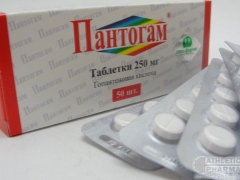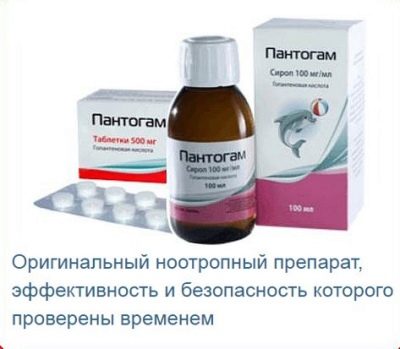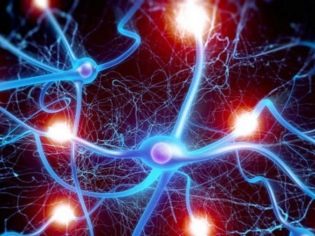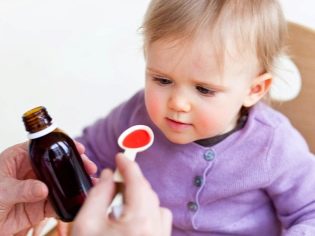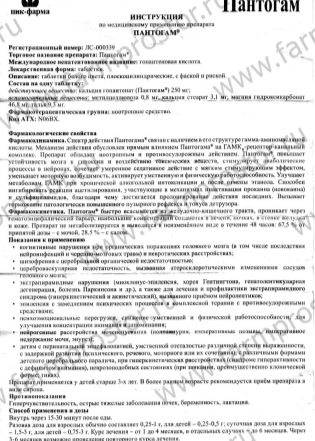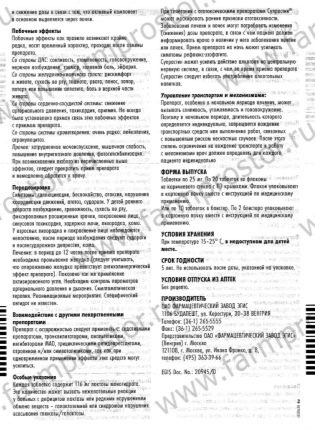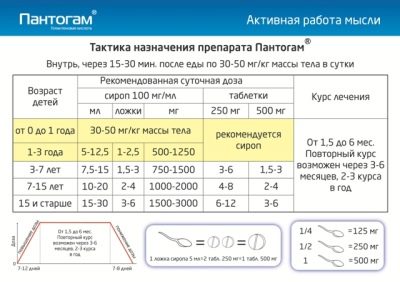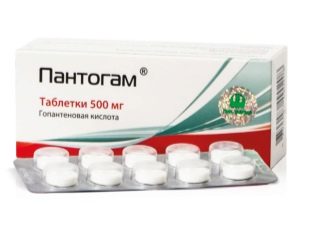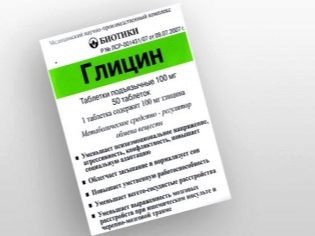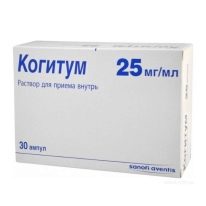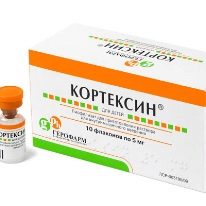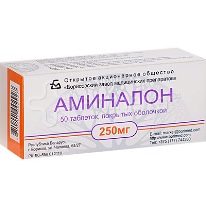Tablets "Pantogam" for children: instructions for use
Among the nootropic drugs that positively affect the nervous system, a medicine called “Pantogam". Children are more likely to buy such a drug. in the form of syrup, but it is also available in tablets. When can they be used in childhood, in which diseases, in what dose and how to give this medicine to a child correctly?
Release form
Tablets "Pantogam" are characterized by a round and flat shape, white color, the presence of risks. They are packaged in blisters of ten pieces and are sold in packs of 50 pieces.
Composition
The action of "Pantogam" is provided by a substance called hopantenic acid. As part of the tablets, it is represented by the form of calcium hopantenate (this form of acid is called “pantogam”). The amount of this ingredient in a single tablet is 250 mg or 500 mg. It is complemented by substances that give the drug a dense structure - calcium stearate, magnesium hydroxycarbonate, methylcellulose and talc.
Operating principle
"Pantogam" is a group of nootropic drugs, since such tablets have the ability to protect the brain from lack of oxygen or the effects of various toxic compounds. Due to the reception of "Pantogam" metabolic processes in the brain tissues are accelerated, the efficiency increases, and the excitability of neurons is normalized. In such a medicine, some anticonvulsant effect is noted, as well as the property to reduce the detrusor tone and inhibit the gall reflex if it is pathologically elevated.
The ingredients of the tablets are absorbed in the gastrointestinal tract quickly and penetrate into the cells of the liver, stomach, skin, kidneys, brain and others. Within 2 days after taking calcium gopantenate leaves the patient's body unchanged. About 2/3 of the drug is excreted by the kidneys, and the rest goes to the stool.
Indications
«Pantogam"Used for such diseases and problems of a neurological nature:
- Mental retardation.
- ADHD
- Stuttering.
- Nervous tick.
- Epilepsy.
- Cerebral palsy.
- Neurogenic disturbance of urination.
- Delayed development.
- Reduced performance.
- Schizophrenia.
- Extrapyramidal Disorder.
- Perinatal encephalopathy.
- Enuresis.
- Mental overload.
- Violation of memorization or attention.
- Traumatic brain injury.
- Cognitive impairment due to neuroinfection.
- Toxic brain damage.
At what age is children prescribed?
The solid form of Pantogam is not used in children under 3 years of age. If treatment is required for a child who has not yet turned 3 years old (for example, an infant baby), Pantog is prescribed in syrup. Such a sweet liquid medicine is allowed from birth.
Contraindications
“Pantogam” tablets are not prescribed not only for small children, but also in such situations:
- If the child has intolerance to any ingredient of the medication.
- If a small patient has been diagnosed with severe acute kidney disease.
Side effects
Acceptance of the tablet “Pantogam” can lead to negative reactions of the central nervous system of the patient, which are manifested by severe agitation, insomnia, dizziness, noise in the head, lethargy, inhibited state and other symptoms. Often, when they occur, the dosage of the drug is reduced, and this undesirable reaction passes.
In some children, treatment with Pantogam tablets provokes allergies in the form of a skin reaction, a runny nose, or conjunctival inflammation. In case of symptoms of intolerance, the drug should be discontinued.
Application
According to the instructions for use, "Pantogam" is recommended to take in the morning or daytime (no later than 17 hours) after eating about 15-30 minutes. A single dosage of tablets in children is 0.25-0.5 g. Per day, children usually receive from 0.75 g (three tablets of 250 mg) to 3 g (6 tablets of 500 mg). The dose is determined on the basis of the disease in which the medicine is prescribed.
For example, if a small patient has epilepsy and is additionally prescribed anticonvulsants, then it is enough for him to receive 0.75-1 g of Pantogam per day (3-4 tablets of 250 mg). The same dosage is prescribed to eliminate the effects of infectious brain damage or traumatic brain injury. In case of nervous ticking, the medicine is given in a dose of 0.25-0.5 g three to six times a day.
The duration of treatment also depends on the diagnosis - on average, the medication is taken 1-3 months, although in some cases the therapy is extended for up to 6-12 months. Between courses "Pantogam", if the drug must be given again, take a break of 1-3 months.
The medicine should be drunk according to a special scheme: the first 7-12 days increase the dose, starting with the minimum, then from 15 to 40 days the patient should take the pills in the largest dosage, which is used for his illness. After that, the dose is gradually reduced to complete abolition (this reduction takes about a week).
Overdose
In case of exceeding the dose of tablets, the child has side effects from the central nervous system (lethargy, dizziness, etc.). For the treatment of overdose using gastric lavage, activated charcoal, other symptomatic agents.
Combination with other medicines
- Do not give children the same time "Pantogam" and others nootropics or drugs that stimulate the nervous system, especially if treatment with Pantogam is long.
- The drug enhances the therapeutic effect of anticonvulsant drugs, so they are often prescribed together.
- Taking Pantogam reduces the risk of adverse effects on the body of neuroleptics and barbiturates.
- In conjunction with "Glycine"The drug acts more effectively.
- The use of Pantogam also increases the effectiveness of local anesthetics.
Terms of sale
Pantogam tablet form, as well as syrup, is sold by prescription given by a pediatrician, neuropathologist or other specialist. Packaging tablets of 250 mg costs about 370-420 rubles, and the average price of a pack of medication containing 500 mg of gopanthenate calcium in each tablet varies from 580 to 700 rubles.
Storage conditions
The shelf life of tablets 250 mg is 4 years, and the drug with a dosage of 500 mg is stored a little less - 3 years from the date of manufacture. Keep the medicine should be in a place hidden from children, and the storage temperature should not exceed +25 degrees.
Reviews
On the use of "Pantogam" in children you can see a lot of good reviews. Although syrup is more often chosen for children, tablets are also in demand among those patients who swallow them without any problems, since many mothers do not like the presence of flavoring and aspartame in the liquid Pantogam composition.
The medicine is called effective and they note that it reduces fatigue, improves attention, helps with developmental delay, and eliminates the effects of brain injury. Many reviews confirm the effectiveness of pills for enuresis, hyperactivity and other neurological problems.
However, some parents did not notice the positive effect from the use of Pantogam, and sometimes the child has adverse reactions, which are also noted in the complaints about the drug. The disadvantages of the drug include its high cost, because the course of treatment is long.
Analogs
Replace "Pantogam" tablets can "Pantokaltsinom", which also produced in solid form, prescribed for the same diseases and used in children over three years. In addition, instead of "Pantogam" the doctor may recommend another nootropic drug. Among the drugs of this group are the most popular:
- «Glycine». Such sweet-tasting pills are recommended to dissolve in the mouth to normalize sleep, calm the child, stimulate mental activity, protect the brain during stress and increased stress. The drug is prescribed from birth, but patients younger than three years are given only under the supervision of a physician.
- «Anvifen». Such capsules contain aminophenylbutyric acid and are in demand in the treatment of asthenia, enuresis, stuttering, insomnia, and other problems. In the treatment of children they are used from 3 years.
- «Kogitum». This solution is produced in glass ampoules and taken internally. It has a pleasant banana taste, and acetylaminosuccinic acid is the main component. The drug is prescribed for various pathologies of the nervous system, for example, with neurosis, after injury, or if a delay in development is detected. The drug is allowed from the age of seven, but in some cases it can be administered to patients younger than 7 years.
- «Cortexin». This medicine injections improves brain function and helps in the treatment of many neurological diseases. He is discharged at different ages, including newborn babies, for example, if they have suffered a brain injury during childbirth.
- «Aminalon». Such tablets contain GABA and are used in the treatment of cerebral palsy, intracranial injuries, developmental delays, depression and many other problems. Children are prescribed at the age of 1 year and older.
